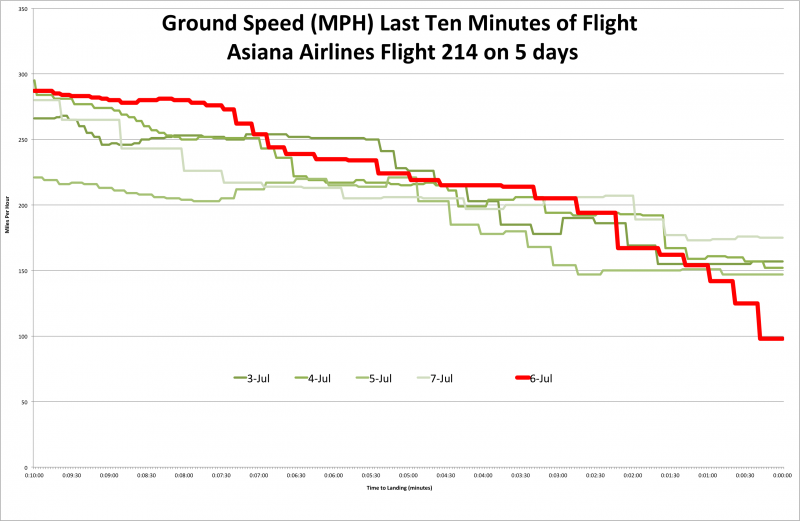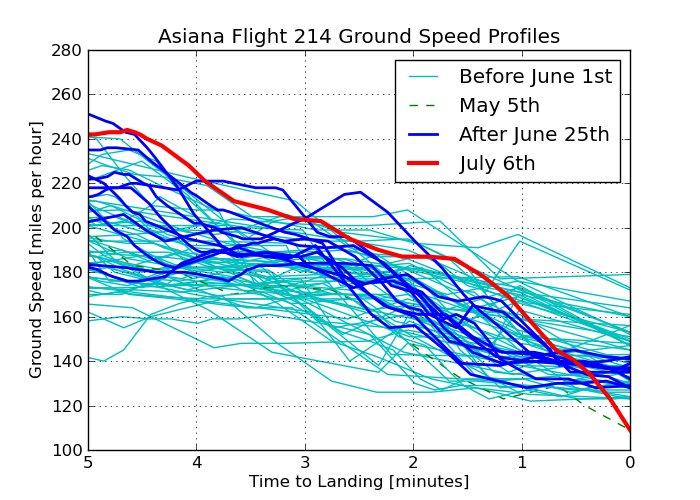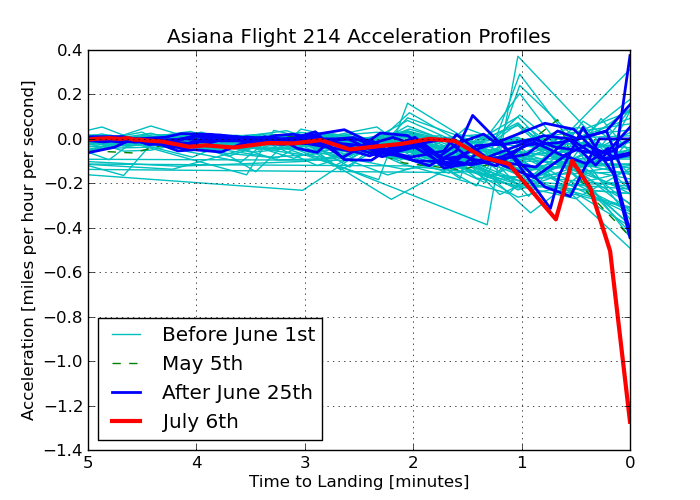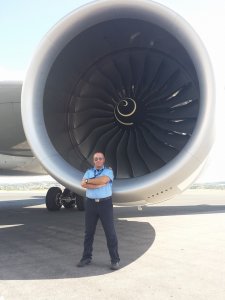Here's the latest info. based on NTSB interviews, ATC recordings, flight paths and airport information at the time.
There is a significant amount of background info. involved, so will get that out of the way first to paint the picture.
The point of all this is for understanding and awareness, not to place blame or find fault.
Also, there is still some information missing such as complete interview transcripts, aircraft configuration at important points etc.
But there is enough information to show many of the factors involved.
Airport Environment: SFO has always had issues with arrival volume due to some unique aspects of its construction, location and weather.
-The main landing runways, 28L and 28R, are only 750 ft. apart.
That means normal simultaneous approaches in IMC or instrument meteorological conditions cannot be conducted.
Normal simultaneous ILS runway separation is 4300ft. min., and there have been plans
to move 28R out the required distance into the bay.
Legal and environmental factors are still preventing that from happening and no new date has been set for the relocation of 28R.
This can cause normal flight paths to be adjusted for aircraft separation and a need
for the controllers to try to obtain visual approach acceptance by pilots to expedite landings when flight conditions permit.
-The surrounding major airports around SFO, SJC and OAK, have conflicting traffic paths, namely OAK arrivals and SJC departures, during normal westerly operations, and SFO arrivals.
This can cause frequent cleared changes in speed and heading while also causing aircraft to become moderately high on the approach path to clear other conflicting aircraft paths.
-SFO commonly has IMC or instrument meteorological conditions which means aircraft separation must be increased and pilots cannot accept visual approaches.
This is what causes most of the delays at SFO since the closeness of the runways causes the two landing runway international airport to essentially become a single landing runway airport.
-SFO commonly does maintenance on the ILS or instrument landing system during VMC or visual meteorological conditions because of the frequency of IMC there ie. it's their only chance to do maintenance rather than close one of the runways that could close the airport.
Communications environment: SFO is one of the busiest international airports in the US.
That means that even though there are ELPR's or English language proficiency requirements for pilots, often those proficiency levels are suspect.
What this does is require multiple radio calls and repeated need for clarification from some international pilots and controllers.
This can reduce the time and increase the workload for pilots to do their jobs.
Cultural environment: It has been well documented in aviation training histories that some cultures have a tendency to automatically defer to authority and try to "save face" when a superior is recognized as making a mistake or underperforming.
It was sometimes present in the US back in the pre-'80's and after a major aviation accident, became one of the foundations for modern CRM or crew resource management.
While it seems that CRM has drastically improved safety with most airlines, there may still be some cultural differences with some countries that will cause pilots to still defer to authority or superiors while not pointing out discrepancies from objectives and safety.
Pilot experience/training: Over the last few years it has become obvious that training and experience of pilots needs to be reexamined.
With the Colgan and Air France accidents lately, and others before them, a review of strategies to ensure pilot competency have come under the microscope.
Unfortunately, due to the costs associated with fuel, aircraft, insurance etc., and tightening economic times, pilot training and experience has become increasingly simulator based.
This has also caused more flight automation to be used to help "unload" pilot attention and awareness, especially since the sim environment and real aircraft operations are very different in the real world of real time multiple issues and events and the resulting stresses those create.
Pilot condition: Obviously a major issue to a pilot performing at their best is to be well rested, nourished and in a healthy state of mind.
It's also important to have distractions removed from the flight deck. Pilots are usually well versed in compartmentalizing emotional issues while flying, but they still can be a factor in simply distracting or reducing the efficiency of the pilot. Don't really have any information on this regarding Asiana 214, but it could have been a factor.
Boeing 777 factors: Although it's been reported the pilot in training only had ~40 hours in the 777, it is common for transitioning pilots to be very experienced in other aircraft, which he was, yet low time in the aircraft they're training on. The captain being trained in the 777 had previously come from flying the Airbus A320. An interesting point because the A/T system in the A320 is slightly different with different names and indications than the Boeings have.
Moving on to the specific events that day that led up to the accident, there are still pieces missing
such as configuration stages, complete CVR or cockpit voice recorder records and complete interviews from the pilots.
First a review of the facts and then some insight into how everything fits together and likely reasons for what happened based on the fair amount of information out now.
But just to be clear, this is one person's view with incomplete information and there may be additional information that comes out which could bias towards conclusions differing from the following.
Weather: KSFO 061756Z 21006KT 10SM FEW016 18/10 A2982 RMK AO2 SLP097 T01780100 10183 20128 51005
Approach: Visual 28L which means the pilots had the airport in sight, accepted responsibility for the approach and aircraft separation.
Aircraft: No emergencies declared, no deferred items affecting the aircraft's ability to conduct the approach and landing.
No mention of systems which failed enroute or on the approach.
Path and performance:
Altitude...........Alt. Dev..............Speed............Spd. Dev......Distance...........Comments
A. 6000-1800ft.......+500ft.............220-170kt.........+0..............12-4mi............fairly normal except approaching 1600-1800ft.
B. 1600.................+500.................170..... ..........+30.............3.5................fast at the FAF, disconnects A/P, turns off F/D
C. 1000.................+300.................140..... ..........+5...............2.5.................... correcting as expected, fairly normal
D. 500...................-50....................134...............+0........ .......1.5................starting to get low, on speed, PM says pull back for low path, see below
E. 200..................~-60..................118...........~-15-20...........~.8............getting low, very slow, instructor moves to push throttles up
F. 100.................~-70...................110...........~-25................~.5...........excessive sink, extremely slow, throttles up
G. 3 sec to impact..~-80..................103..........~-30+...............~.2...........leveling off above water, engines going to max thrust but excessive angle of attack
H. 1.5 sec-ground...........................106..........~-30..................0.............aircraft accelerates ~5kt.
I. Gear and tail strike sea wall, gear collapses, tail departs
Perspective: What jumps out is how normal the approach is until approx. 1800 ft.
Even though the acft. is high by 500ft. all the way to 3.5 miles, this can be fairly normal at SFO with the above factors of approach paths, visual rules and compensating for the other airports and aircraft.
Their high path correction makes the fact that the A/T's are possibly not engaged masked because he's trading altitude for airspeed.
Regardless of if the A/T's are engaged or not, the PF and PM are still responsible to manage airspeed manually with their hands on the throttles.
But if a pilot is used to the A/T controlling speed for him without scanning the speed, it can cause a false sense of security with speed control and the need to always scan it.
What happens then is interesting and fairly common actually.
And the key here are 3 things related to vertical control and indications of the aircraft:
- Mode control panel (MCP) interaction with flight director indications (F/D)and flight management annunciations (FMA)
- Autothrottle (A/T) interaction with MCP and FMA
- How the pilot normally flies the automation, FMA scan and hand flying technique
The standard procedure on a visual approach is to set the final approach fix (FAF) or last altitude on the ILS in the altitude window on the MCP
as you're cleared for the visual approach.
This provides an altitude target and safety for being stabilized and configured.
Different airlines have different procedures at that point for altitude window procedure, either to set touchdown zone elevation or go around elevation.
The flight director pitch during the descent will be determined by the MCP vertical function selected.
But, and this is a big but, it changes the A/T function and safeguards depending on what is selected.
The A/T is always armed (if the switches (L&R) are on and they should be), and if the aircraft is slow in most vertical modes, near the speed tape hash limit marks, will automatically reengage and add power (also known as A/T wakeup),
unless in FLCH or level change mode..........
This is why most airlines make it against procedure to select FLCH inside of the FAF to retain the A/T wakeup mode.
So as they're descending from 6000ft., they get cleared for the visual approach, the non-flying pilot puts the FAF altitude in the MCP which is 1800ft.,
and they FLCH or V/S the vertical mode down to get on the assumed vertical slope.
All Boeing jets with FMC's can build a virtual glideslope indication even if the ground based ILS is out (as it was) and use that as a reference, also called a VNAV approach.
The problem as stated earlier with SFO is they often give changes on the visual approaches, that happen too fast for the computer to recompute and capture.
So most will use the VNAV vertical slope indication as a reference but hand fly the jet down due to the rapid changes that can happen on a visual approach.
Continuing, they are in FLCH or V/S and approaching the FAF at 1800ft., the MCP, FMA and F/D will capture the altitude, the vertical FMA will go to altitude hold, the A/T will come back on and add power to maintain the MCP speed and the aircraft will accelerate.
This is probably why at this point, the pilot flying the jet (PF) turns off the autopilot, disconnects the A/T and turns off his F/D, because he's high, fast and doesn't want the airplane getting farther off the vertical path by leveling and the power automatically coming up.
At this point the PM's F/D isn't giving good info., because the airplane thinks they wanted to level off at 1800ft., the FAF, and so the pilot monitoring (PM) in this case the instructor pilot, changes the altitude in the MCP and hits FLCH to get "his" F/D to give a descent indication. But remember, the FLCH function disables the A/T wakeup mode.
Now the FP believes he has the A/T because he never uses FLCH on an approach, yet it's not going to come on to correct his speed because the PM selected FLCH to get his F/D back.
He gets on path and speed around 500ft which is fine, starts raising the nose
to maintain path, but the aircraft is still sinking at the previous excessive rate that he had to be on to capture the vertical path, because remember he was high.
A 777 with idle thrust and decaying airspeed with full flaps and gear down will set up a significant sink rate that only a large thrust increase will arrest.
In fact all airlines would go around upon seeing that under 500ft.
But he's thinking the A/T's will come up and provide thrust, yet they're not. (he has to move the throttles with his hands to override the A/T and he's not)
At this point the airplane is sinking excessively, yet there seems to be a lack of any communication to resolve the issue. Training, overload, stress, scan assumption/failure, communication, culture?
At approx. 7 seconds to impact the instructor pilot notices the speed and moves to the throttles, calls go around at 2-3 secs., and the rest is as it happened.
Imho, it will come out that the PF and PM had a communication issue between what was desired, what was selected, and what was expected with the MCP, F/D and A/T in addition to major scanning issues
The PF, and in this case PM since he was responsible as the instructor, still are responsible to scan, cross check and fly the airplane regardless of automation assumptions.
In the interview the instructor pilot said, he thought the autothrottles were maintaining speed.
This goes back to the idea that real world training has suffered, although it satisfies a simulator and written test from computer training.
Another factor, and it will be discussed, is the "technique" for some to turn the A/P off, yet leave the A/T on.
So the pilot is hand flying the yoke yet the A/T is controlling the throttle.....I've watched this happen over and over,
the PF starts scanning everything "except" speed because he's gotten in the habit of the A/T controlling the speed for him, and
for whatever reason, the A/T disconnects, the FMA that it's disconnected is missed and the airplane starts slowing down.
Imho it should be A/P on for everything or off for everything, ie. it's you or the plane controlling inputs, not a combination.
Also, the procedure to not drug/alcohol test the pilots due to them being foreign needs to be changed imho.
Here is an interesting animation/narration of the Turkish accident in 2009, that while different in lead up causes,
resulted in a similar confusion about the A/T and an almost identical outcome.

















 Απάντηση με παράθεση
Απάντηση με παράθεση






